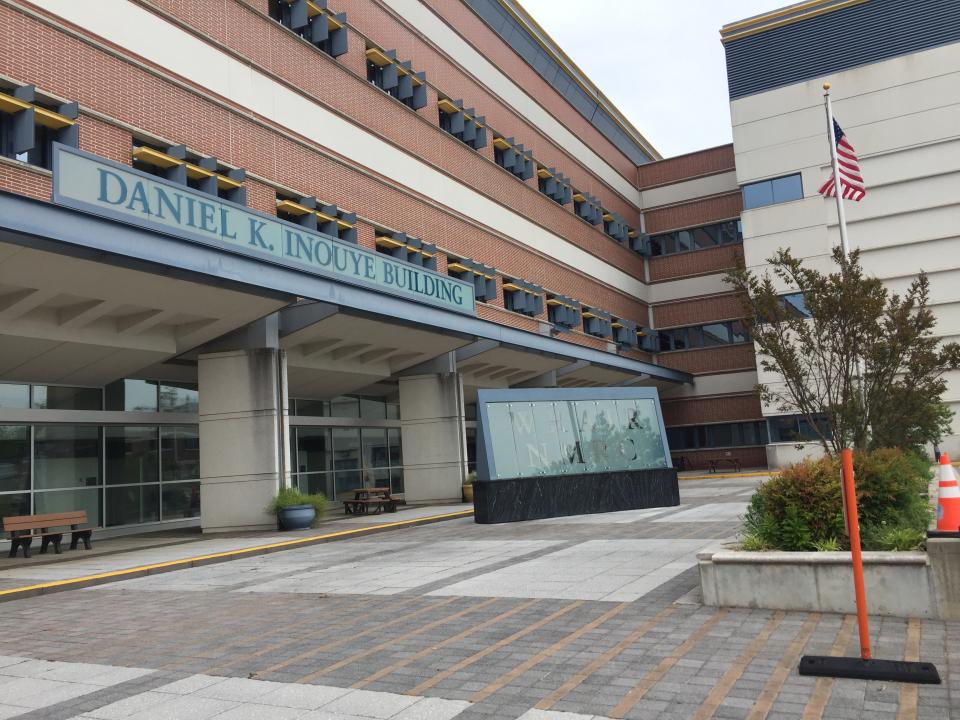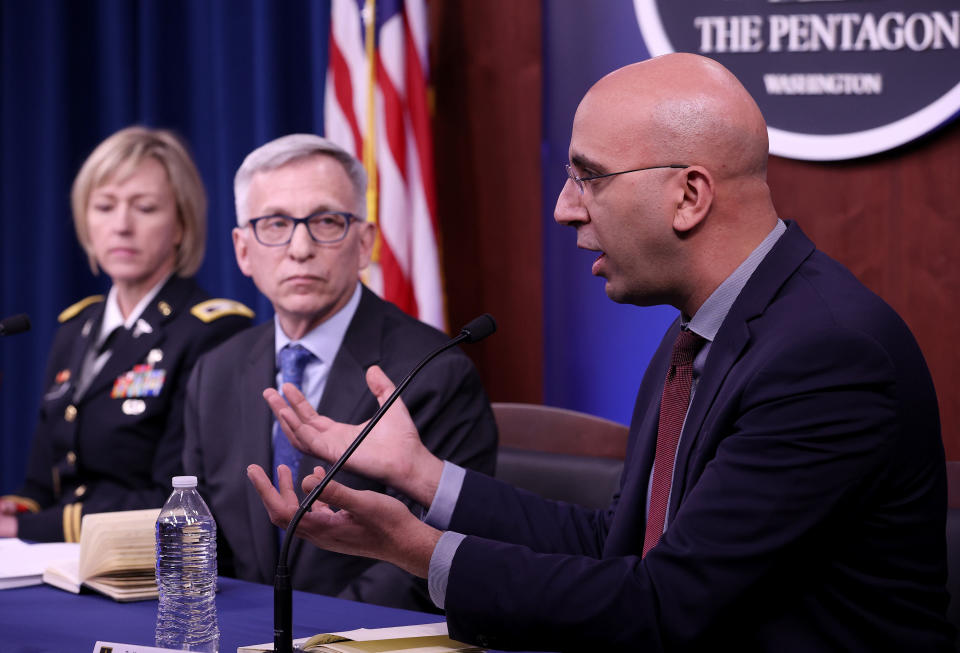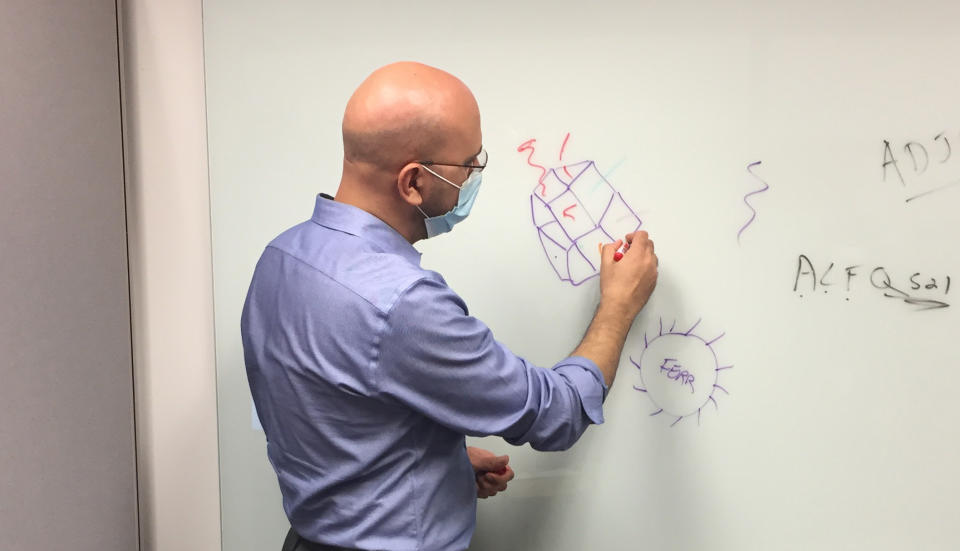'Another one was coming': Army scientists working on vaccine had long feared emergence of new coronaviruses
SILVER SPRING, Md. — On. Jan. 10, the day Chinese scientists published the coronavirus’s genetic sequence, Kayvon Modjarrad received a late-night call from his colleague Dr. Gordon Joyce, chief of the Emerging Infectious Diseases branch’s structural biology section at the Walter Reed Army Institute of Research.
Joyce and Modjarrad, the director of the Emerging Infectious Diseases branch, had been working on coronaviruses together since 2012, when they were both research fellows at the National Institutes of Health’s Vaccine Research Center. They continued that work when WRAIR hired them away from NIH about five years ago. Indeed, when SARS-CoV-2 emerged, “we were the only ones actually in the DoD, at that moment, who were working on a coronavirus, in terms of research and development,” Modjarrad said.
The arrival of SARS-CoV-2 surprised neither doctor. “There were two coronaviruses that caused the common cold that were identified in people [from] 1965 to 2002,” Modjarrad said. “Since 2002 there have been five new human coronaviruses that have been isolated and dozens of bat coronaviruses as well. So this acceleration made us concerned that another one was coming.”
The hub of the U.S. military’s effort to develop a vaccine for the coronavirus is deceptively quiet.
At WRAIR, a team of almost 100 scientists is engaged in a multimillion-dollar round-the-clock sprint to find a solution to the pandemic that in the course of three short months has sent a booming economy into depression and killed more than 80,000 Americans. The team has already designed a unique vaccine candidate that Army Secretary Ryan McCarthy describes as one of the “top 15” under development in the world.
But in the institute’s modern headquarters building in the Maryland suburbs of Washington, D.C., the hallways and corridors are almost deserted. The voices of the occasional uniformed soldiers or civilian scientists who stride by echo in the emptiness. There is little hint of the potentially history-making work being done behind the closed doors of their offices and laboratories.

The stillness is partly explained by the fact that many of the building’s roughly 1,500-strong workforce are now practicing social distancing by working from home. But it also owes something to the fact that the vaccine team has been divided into shifts to enable its vital work to continue on a 24/7 basis.
Money is not a problem. Funding comes from the $75 million that, according to Assistant Secretary of Defense for Health Affairs Tom McCaffery, the Defense Department has poured into vaccine development since January. As a result, WRAIR’s Emerging Infectious Diseases branch became what Modjarrad, the man leading the vaccine effort, describes as “a mini Manhattan Project,” in reference to the top-secret U.S. program to develop the atomic bomb during World War II.
The coronavirus pandemic represents the most serious global health threat in more than a century, but the challenge of developing vaccines is nothing new for WRAIR (pronounced “rare”). Founded as the Army Medical School in 1893 and renamed in 1953 after Maj. Walter Reed, an Army doctor who led teams that did groundbreaking research into the spread of typhus and yellow fever, the institute has become a world leader in medical research. Its alumni include two members now serving on the White House coronavirus task force: Dr. Robert Redfield, the director of the Centers for Disease Control and Prevention, and Dr. Deborah Birx.
Along the way, the institute has made vaccine development a specialty. It was that history that drew Modjarrad, 43, to WRAIR five years ago from the nearby National Institutes of Health, where he worked under Dr. Anthony Fauci, another White House task force member and the government’s leading scientific voice on the coronavirus. “I came to WRAIR because of its long legacy in vaccine development,” Modjarrad told Yahoo News in an exclusive interview in his office. “Half of the vaccines that are licensed, WRAIR has been involved in their development in some way.”
A New Jersey native and a graduate of Duke University, where he studied biology, Modjarrad received MD, master of public health and doctorate degrees from the University of Alabama. His work on HIV, Ebola, Middle East respiratory syndrome (MERS) and severe acute respiratory syndrome (SARS) has made him one of the country’s leading authorities in vaccine development. Now he faces perhaps his greatest challenge, leading the U.S. military’s effort to find a vaccine to stop the coronavirus, which he refers to by its more scientific name — SARS-CoV-2.
When the Chinese announced the new virus’s genetic sequence, Modjarrad and Joyce were ready. During their late-night call, they discussed the new information and how it compared with previous coronaviruses they had worked on, and Modjarrad decided to pivot his entire organization toward developing a vaccine for SARS-CoV-2. Before hanging up, they had already begun designing the basis for that vaccine.
The expertise resident in Modjarrad’s team quickly brought them to the attention of senior Army leaders who are usually more focused on shifts in the defense budget, major training exercises or combat operations in Iraq and Afghanistan than research at a small lab that many in the Army don’t know exists. “Within the first few weeks of this, we were summoned to the Pentagon to give an update on what we were doing,” Modjarrad said.

Modjarrad’s team is part of Operation Warp Speed, which the Trump administration hopes will accelerate the development of a vaccine by up to eight months. Whether or not that is possible, the high-level attention means Modjarrad and his colleagues do not want for resources.
“In these situations, the seas part and you can go as fast as the science will allow you,” he said. “That’s an amazing thing for a scientist and a physician like myself, to be able to really just go full speed and the science is the limit to get to a product.” That approach, together with the work they had done developing vaccines for previous coronaviruses, meant Modjarrad’s team has been able to reduce the first phase of vaccine research, which he termed “the discovery and design phase,” from “a couple of years to a couple of months.”
That phase required the team to select a platform — the vehicle by which the substance meant to provoke an immune response is delivered to the body — for their vaccine. What makes the WRAIR team’s approach unique is that for their platform they chose to use ferritin, a protein used to carry iron by nearly all living organisms.
Modjarrad and some of his team had already spent two years experimenting with ferritin as a platform for a universal flu vaccine, including testing it on humans. The advantage of that work became clear during a World Health Organization meeting held Feb. 11 and 12 in Switzerland to organize global research efforts regarding COVID-19, the disease caused by the coronavirus, according to Modjarrad, who attended as one of the few U.S. representatives. At the meeting, it was decided that in order to save time, “we needed to prioritize vaccine candidates that are based on platforms that have been in humans,” said Modjarrad, who serves on the WHO’s expert panel for vaccine research and development. Ferritin seemed to fit the bill perfectly.
But ferritin also has another major advantage: When the distinctive protein spike of a coronavirus is introduced to a ferritin molecule, the molecule “self-assembles” into something that resembles a soccer ball with 24 outward-facing panels, meaning that the vaccine is now presented up to 24 times, provoking a significantly greater immune response than if a person’s immune system detected it only once. Since then, Modjarrad and his boss, Dr. Nelson Michael, director of WRAIR’s Center for Infectious Disease Research, have briefed Army Secretary McCarthy and Army Chief of Staff Gen. James McConville regularly on their progress. “They’ve been asking all the right questions and making sure that any obstacles in our way are cleared before it even gets to the point of slowing us down,” Modjarrad said.
Because SARS-CoV-2 has emerged in humans so recently, it has not had much time to mutate, which means vaccines currently in development, if they prove effective, will likely be applicable “to all the virus strains in the world,” Modjarrad said. However, “the longer something’s in the population, the more opportunity it has to mutate,” he said.

But even if the virus mutates into different strains — like the flu, which requires a different vaccine each year — a ferritin platform’s 24 panels will allow scientists to mix and match the protein spikes from different coronaviruses in the same molecule, allowing for one vaccine to cover all the different strains, and maybe even other coronaviruses, according to Modjarrad.
Ferritin is not the only unique feature of the WRAIR team’s coronavirus vaccine candidate. In addition to a platform, a vaccine needs something called an adjuvant, which enhances the vaccine’s effect. Aluminum is often used, but the Army has just patented a new adjuvant called ALFQ that is about to go into clinical trials at WRAIR as part of a malaria vaccine. Modjarrad is optimistic that ALFQ will complement his team’s SARS-CoV-2 vaccine as well.
The team is currently testing several variants of their vaccine on hundreds of mice. In essence, the idea is that the vaccine is supposed to train a mouse’s immune system to recognize the coronavirus as something it wants to find and eliminate. “In the next couple of weeks … we’ll test their blood for antibody responses to SARS-CoV-2,” Modjarrad said on May 5. The variant “that has the best responses is the one that we take forward” into human trials.
But preparing a vaccine for human trials is a complex process that needs to be undertaken with extraordinary care to ensure the vaccine is safe, a process likely to take several months. “Even though we are going to accelerate as much as possible, we will not take any shortcuts in safety,” Modjarrad said, adding that the vaccine should be ready for human trials later this summer.
Those first trials will likely involve only a few dozen people and are aimed at making sure the virus is safe and induces an appropriate immune response. “Within the first two months of vaccinating people, we’ll know whether this is good enough to move on to much larger trials,” Modjarrad said.
Neither the initial trials nor the follow-on wider human trials will be so-called “challenge trials,” in which humans are deliberately exposed to the virus. This is partly because it’s preferable to have a good therapeutic drug for a virus available during a human challenge trial, and partly because there are enough people in the Washington area getting infected that there’s no need to deliberately infect the trial participants, according to Modjarrad. “Nature is your experiment, so you don’t have to introduce the experiment yourself by giving it to them,” he said. There will be parallel challenge trials, but they will happen at the Army’s high-security laboratories at Fort Detrick, Md., and involve monkeys, not humans.
For Modjarrad and his colleagues who are also working on therapeutics to treat COVID-19, the pace is unrelenting. Eighteen-hour days and 100-hour weeks are not unusual, he said, adding that no member of the team has had a day off in three months.
“It is all-consuming, it is saturating,” he said. But he and his colleagues are keenly aware of the responsibility that has been thrust upon them. “Our whole lives, our training, have been for this moment.”
Even if all goes well, Modjarrad does not expect to have a vaccine widely available until the summer of 2021, meaning there is little prospect of a near-term respite. “But that’s OK,” he said. “We’ll all take a nice long vacation once we get a vaccine.”
Cover thumbnail photo: Dr. Kayvon Modjarrad, ferritin and COVID-19. (Photo illustration: Yahoo News; photos: Sean D. Naylor/Yahoo News, Getty Images [2])
_____
Click here for the latest coronavirus news and updates. According to experts, people over 60 and those who are immunocompromised continue to be the most at risk. If you have questions, please refer to the CDC’s and WHO’s resource guides.
Read more:



